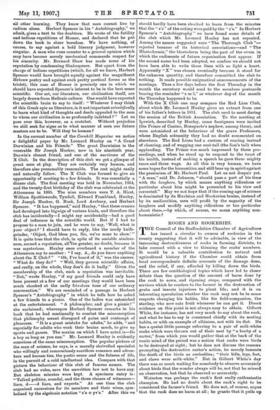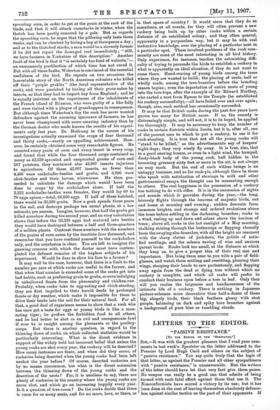ROOKS AND ROOKERIES.
111HE Council of the Staffordshire Chamber of Agriculture 1 has issued a circular to owners of rookeries in the 'county suggesting that it will be advisable, in view of the increasing destructiveness of rooks in farming districts, to take counsel with a view to thinning the rooks' numbers. It would be a valuable contribution to natural and agricultural history if the Chamber could obtain from local correspondents definite accounts of the damage done, and the relief, if any, afforded by killing down the birds. There are few ornithological topics which have led to closer debate than the question of the amount of harm done by the rook to sown, and ripening crops, compared with the services which he renders to the farmer in the destruction of grubs and insects injurious to plant life; and it is an interesting speculation whether the rook may not be in some respects changing his habits, like his field-companion, the starling, who now eats fruit whenever he can get it. Direct evidence on this point is not always easy to obtain. Gilbert White, for instance, has not very much to say about the rook, and what he has to say is concerned chiefly with its nesting habits, or with an example of albinism, not with its diet. He has a quaint little passage referring to a pair of milk-white rooks which were thrown out of their nest by "a booby of a carter," from which you would gather that at the back of the rustic mind of the period was a notion that rooks were birds to be destroyed at sight ; but be does not discuss the reasons- prompting the destructive carter's action, he merely laments the death of the birds as curiosities ; "their bills, legs, feet, and claws were milk-white." But in Gilbert White's day there was so much waiting for somebody to observe accurately about birds that the wonder always will be, not that he missed an observation, but that he observed so accurately.
Waterton was perhaps the rook's first really enthusiastic champion. He bad no doubt about the rook's right to be considered the farmer's friend. He does not, of course, argue that the rook does no harm at all ; he grants that it pulls up sprouting corn, in order to get at the grain at the root of the blade, and that it will attack cornstacks in winter, when the thatch has been partly removed by a gale. But as regards the sprouting corn, be urges that the pilfering only lasts three weeks, and can be checked by hiring a boy at threepence a day ; and as to the thatched stacks, a man would be a slovenly farmer if be did not repair the damaged roof immediately ; "still, we have farmers in Yorkshire of this description." Another fault of the bird is that it " is certainly too fond of walnuts,"— an unmannerly predilection of which time has not cured it. Bat with all these faults, Waterton is convinced of the essential usefulness of the bird. He repeats on two occasions the lamentable story of the North American colonists who killed off their "purple grakles" (the local representative of the rook), and were punished by having all their grass eaten by insects, so that they had to import hay from England ; and he is equally insistent on the experiences of the inhabitants of the French island of Reunion, who were guilty of a like folly and were visited with a plague of grasshoppers in consequence. But although since Waterton's day the rook has never wanted defenders against the accusing ignorance of farmers, Le has never been championed with more amazing industry than by the German doctor who made known the results of his experi- ments only last year. Dr. Hollrung in the course of his investigations actually examined the crops of four thousand and thirty rooks,—surely an appalling achievement. How- ever, he certainly obtained some very remarkable figures. He counted every grain of corn and every insect in every crop, and found that while the four thousand crops contained as many as 42,239 sprouted and unsprouted grains of can and 587 potatoes, they contained also 43,997 insects injurious to agriculture. Of these 43,997 insects, no fewer than 4,486 were cockchafer-beetles and grubs, and 3,896 were click-beetles and their larvae, wireworms. He then pro- ceeded to calculate the damage which would • have been done to crops • by the cockchafers alone. If half the 2,222 cockchafer-beetles were females, they would lay 60 to 70 eggs apiece,—total, 66,660 eggs. If half of these hatched, there would be 33,330 grubs. Now a grub spends three years in the soil, and destroys perhaps ten cereal plants, at a low estimate, per annum. Imagine, however, that half the grubs get killed somehow during the second year, and an easy calculation shows that before the 33,330 eggs had matured into beetles they would have destroyed between a half and three-quarters of a million plants. Contrast these numbers with the numbers of the grains of corn eaten by the insatiate four thousand, and remember that you have confined yourself to the cockchafers only, and the conclusion is clear. You are left to ima:gine the gnawing remorse with which the doctor must have contem- plated the defunct remains of the hapless subjects of his experiment. Would he dare to show his face to a farmer?
It may well be the case, however, that there is a limit to the number per acre at which rooks are useful to the farmer, and that when that number is exceeded some of the rooks get into bad habits, such as preferring grain to grubs, or even indulging in unhallowed feasts from the pheasantry and chicken-run. Probably, when rooks take to egg-eating and chick-stealing, they are first impelled to their horrid deeds by prolonged frosts or dry weather, which make it impossible for them to drive their beaks into the soil for their natural food. For all that, a good deal of experience seems to show that a rook who has once got a taste for eggs or young birds is like a man- eating tiger; Le prefers the forbidden food to all others, and he had better be shot as an evil and unregenerate fowl if ever he is caught among the pheasants or the poultry- coops. But there is another question, in regard to the thinning down of rooks, on which collected statistics would be particularly interesting. What is the direct evidence in support of the widely held but incorrect belief that unless the young rooks are shot every year, the rookery will be deserted ? How many instances are there, and when did they occur, of rookeries being deserted when the young rooks had been left nnshot the, year before ? Of course, deserted rookeries are by no means uncommon, but what is the direct connexion between the thinning down of the young rooks and the desertion of, the nests ? For, it is needless to say, there are plenty of rookeries in the country where the young rooks are never shot, and which go on. increasing happily every year. Is it a question of tree-room ? Do the rooks decide that there is room for so many nests, and for no more, here, or there, or
in that space of country-? It would seem that they do so sometimes, at all events, for they will often prevent a new rookery being built up by other rooks within a certain distance of an established colony; and they often quarrel, apparently in a purposeless way, but it may be with real instinctive knowledge, over the placing of a particular nest in a particular spot. These involved problems of the rook com- munity are some of the most interesting in all bird history. Only experience, for instance, teaches the astonishing diffi- culty of trying to persuade the birds to establish a rookery in what is apparently an ideal situation, if they do not want to come there. Hand-rearing of young birds among the trees where they are wanted to build; the placing of nests, half or wholly made, among the tree-branches before the breeding season begins ; even the deportation of entire nests of young into the tree-tops, after the example of Sir Edward Northey, who carted a nest from Epsom to the Temple (he established his rookery successfully),—all have failed over and over again; though, also, each method has occasionally succeeded.
It may be that British rooks during the past few years have grown too many for British acres. If so, the remedy is distressingly simple, and will not, it is to be hoped, be applied too thoroughly. It may be necessary to keep the number of rooks in certain districts within limits, but it is, after all, one of the poorest uses to which to put a rookery, to use it for rook-shooting. It is true that not all the young rooks will "stand to be killed," as the advertisements say of keepers night-dogs; they very wisely fly away. It is true, also, that in a good snoring breeze, or even in a light wind, the bumped, dusty-black body of the young rook, half hidden in the humming greenery sixty feet or more in the air, is not always an easy mark. But the- end of such witless beings is an unhappy business, and as for rook-pie, although there be those who Speak with satisfaction of stewings in milk and other gastronomical essays, the thought can be nauseating enough to others. The real happiness in the possession of a rookery has nothing to do with rifles. It is in the succession of sights and sounds which it provides during the year,—the long, leisurely flights through the heavens of majestic birds, out and home at morning and evening ; sudden descents from immense heights, and strange and ordered evolutions above the trees before settling in the darkening branches; rooks in a wind, reeling up and down and aslant above the horizon of trees ; above all, rooks in the hot sunlight of a May morning, stalking shining through the buttercups or flapping clumsily from the swaying elm-branches, with all the bright air resonant with the sharp clatter of jackdaws, the gobble of satis- fied nestlings, and the solemn cawing of wise and anxious parent birds. Rooks look too small, at the distance at which they keep us, to give a proper idea of their real size and importance. But bring them near to you with a pair of field- glasses, and watch them settling and resettling, pluming their wings, stooping their heads to caw portentously, and flapping away again from the dead or dying tree without which no rookery is complete, and which all rooks will prefer to conduct their business upon before a tree in leaf. Only then will you realise the largeness and handsomeness of the intimate life of a rookery. There is nothing in Japanese picture-schemes more decorative than half-a-dozen of these big, shapely birds, their black feathers glossy with shot purple, balancing on dark and spiky bare branches against a background of pure blue or tumbling clouds.











































 Previous page
Previous page